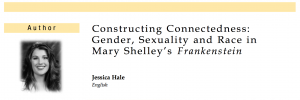In her paper “Constructing Connectedness: Gender, Sexuality and Race in Mary Shelley’s Frankenstein,” the college student Jessica Hale presents the interesting argument of the inarguable homosocial relationships. Her main point with this argument is that “the most intimate relationships on the novel occur not between husbands and wives, but between men and their male friends.” (parr. 5)
Jessica Hale has these exemplary sections of the passage that undoubtedly support her argument of the presence of homosocial relationships. One of the close readings of the passage from Frankenstein is “many a long were the conversations between Lord Byron and Shelley to which I was a devout but nearly a silent listener.” (xxiv) The author uses this passage to describe that probably, Mary Shelley’s experience seeing Lord Byron and Shelley “provided material” (parr. 5) for the proclaimed homosocial interactions in Frankenstein.
Besides referencing her primary source, which in this case is the text Frankenstein itself, Jessica Hale uses secondary sources. She explained Berthold Schoene-Harwood’s perspective when she quotes, “the predicament of the individual male psyche under patriarchal pressure.” (parr. 5) The purpose of this secondary source was to describe, using evidence, that the pressure Victor flees is “the role of a husband and father providing for and perpetually tied to a nuclear family.” (parr. 5)
In the very first sentence of this literary study, Jessica Hale uses the term “encroached.” As an English language learner, one cannot refuse to search up the dictionary for the definition. Not possessing a physical dictionary, accessing the web in “dictionary.reference.com,” the definition of encroached in my own words is to be a able to go beyond the limits the environment establishes.
To recap, Jessica Hale empowers a main argument which she evidences with close reading and utilizes secondary sources and appropriate terms in order to voice her points.
ENG 181: Writing about Science Fiction Literature and Film

